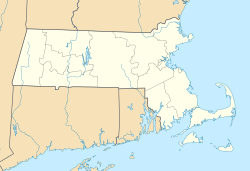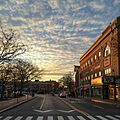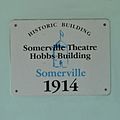Somerville Theatre facts for kids
 |
|
| Address | 55 Davis Square Somerville, Massachusetts United States |
|---|---|
| Owner | FEI Theatres / Frame One Theatres |
| Capacity | 900 / 92 / 31 / 150 / 145 / 92 |
| Current use | cinema, and live music, comedy and dance venue |
| Construction | |
| Opened | 1914 |
| Architect | Funk & Wilcox |
| Website | |
|
Somerville Theater/Hobbs Building
|
|
| Built | 1914 |
| Architectural style | Art Deco |
| MPS | Somerville MRA |
| NRHP reference No. | 89002330 |
| Added to NRHP | 1990 |
The Somerville Theatre is a cool, independent movie theater and concert hall located in the Davis Square neighborhood of Somerville, Massachusetts. It's over 100 years old! This historic building started out as a place for live stage shows called vaudeville, and also showed movies. Today, it's still a popular spot for both live music and showing the newest movies.
Many famous artists have performed here. For example, Bruce Springsteen played two shows in 2003, and U2 performed in 2009. Other well-known musicians like Norah Jones, The Jonas Brothers, and Joan Baez have also graced its stage. The building is also home to the Crystal Ballroom, another great space for events.
Contents
The Theater's Beginnings
The Somerville Theatre is part of the Hobbs Building, which was built way back in 1914. Joseph Hobbs was the person who built it, and the design came from a company called Funk & Wilcox in Boston. The building was made to host all kinds of shows, like stage plays, vaudeville acts, opera, and movies.
But the theater wasn't the only exciting part of the Hobbs Building! It also had a café and a bowling alley in the basement. On the ground floor, there were ten shops and the theater lobbies. Upstairs, on the second floor, was the Hobbs Crystal Ballroom, a huge dance hall that could hold 700 people. The upper floors also had office spaces.
In 1915, a group called the Somerville Theater Players started putting on weekly plays. Some famous actors got their start here, including Tallulah Bankhead and Francis X. Bushman. Even future film director Busby Berkeley, known for his amazing musical movies like 42nd Street, directed many shows at the Somerville Theatre in the 1920s.
The Movie Era Takes Over
In 1926, the Hobbs family leased and later sold the theater to Arthur F. Viano. His family owned other theaters nearby, like the Teele Square Theater and the Regent Theater. The Vianos kept the live theater company going for a while. However, during the tough times of the Great Depression, they had to switch to showing "movies only" starting in 1932.
Throughout the 1930s, 40s, 50s, and 60s, the Somerville Theatre was a top neighborhood movie house. Back then, new movies would first play in big downtown theaters. After that, they would come to neighborhood theaters like the Somerville, often showing two or three different movies each week.
The Viano Theaters were famous for their fresh popcorn. They also had "prize nights," where they gave away dishes, appliances, and other items to get people to come to the shows. These gift nights started during the Depression and continued at the Somerville until the 1970s.
A New Chapter: Repertory Films
In 1982, the Viano family leased the Somerville Theatre to Garen Daly. He changed the theater into a "repertory house." This meant it showed double features and changed movies daily, often featuring independent and unusual films. This was before video and DVD made it easy to find such movies at home.
Garen Daly also brought live performances back to the stage, which hadn't happened since the 1930s. He started having concerts to go along with the movies. During this time, a family called the Fraimans bought the Hobbs Building. When Garen Daly's lease ended in 1989, the Fraimans decided to run the Somerville Theatre themselves. They closed it for a while to make some big improvements.
Some people in the community worried that the theater would be split into smaller movie rooms. They formed a group to try and stop this. But the owners never planned to do that, so the theater was saved and reopened in 1990.
Modern Updates and Restoration
After reopening, fewer people were coming to the movies. So, a plan was needed to keep the theater successful. The rest of the Hobbs Building, except for a few shops and the theater, had been empty since the early 1980s. This empty space became the solution.
In 1996, major renovations began. The old bowling alleys in the basement and part of the ground floor shops were removed to create modern bathrooms and two new movie screens. Two more screens were built in the old ballroom space on the second floor. An elevator was added, along with new windows and a marquee that looked like the original one. The third and second floors became new office spaces.
The theater lobby was made bigger by taking over a nearby shop. New, comfy seats were put in the main auditorium's lower level.
In 2006, more renovations happened. The inside of the main auditorium was restored to look more like its original historical design and colors. The stage also got upgrades, including new curtains, rigging, and a new movie screen.
In 2008, a second gallery of the Museum of Bad Art opened in the basement of the theater. This gallery was near the restrooms, just like the museum's first location. While the original gallery was free, this one was only free if you bought a ticket to the theater. This gallery closed in 2019.
In 2009, the balcony seating was replaced with new seats, as the original ones were from 1914. The main auditorium also got a new Dolby Digital Sound system with 24 surround speakers. The projection booth was updated with special projectors. This means the Somerville is one of the few theaters in New England that can show 70mm film, which is a very high-quality film format. The theater currently has three screens for movies.
During the time the theater was closed due to the COVID-19 Pandemic, screens 4 and 5 were changed back into the Crystal Ballroom. This space is now used again for live music and events.
The Somerville Theatre Today
The Fraiman family, now operating as Frame One Theatres, took over the Somerville Theatre in 1990. They have made many changes to keep up with how movie theaters have changed over time. Since 1990, four screens have been added, and digital projectors have been installed. However, two of the upper-level screens were recently turned back into the Crystal Ballroom.
The theater now operates as a three-screen cinema. It has one of the most advanced projection booths on the East Coast. This means the Somerville can show almost any film format, from new digital movies to older 35mm and 70mm film prints. The theater also has a small, rentable 31-seat "microcinema." All screens (except the microcinema) have 35mm projectors, and the main screen can show 70mm films.
Today, the Somerville Theatre shows both new and older movies, with a focus on independent and art house films. It also regularly hosts live music, dance, and comedy shows. Performers like U2, Louis CK, and Arlo Guthrie have been on its stage.
The theater often shows classic 35mm and 70mm films. It also shows silent films with live music playing along. Since 2016, it hosts a yearly "The 70mm and Widescreen Film Festival" every September. It's also a main host for the Independent Film Festival of Boston and a show called The ...cracker.
The Somerville Theatre is special because it's locally owned and independent, but it also operates as a for-profit business. This is not common in the movie theater world today.
Images for kids
-
Lobby display with memorabilia
See also

















